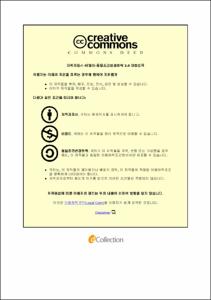Antimicrobial hydrogels based on polyvinyl alcohol and diphlorethohydroxycarmalol (DPHC) derived from brown alga Ishige okamurae : An in vitro and in vivo study of wound healing and tissue regeneration
- Alternative Title
- 항균효능을 갖는 창상피복제 제작을 위한 PVA/Diphlorethohydroxycarmalol (DPHC) 하이드로겔의 in vitro 및 in vivo 연구
- Abstract
- 상처 부위는 박테리아로부터 감염이 되어 질병이나 합병증이 유발되며 상처치유과정에 부정적인 영향을 미친다. 따라서 항균력을 지닌 창상피복제의 활용이 중요한 화제가 되고 있다. 항균효능을 갖는 해양 기능성 소재를 창상피복제에 적용하기 위하여, 해양 갈조류인 Ishige okamurae로부터 Diphlorethohydroxycarmalol (DPHC)을 HPLC와 HPCPC를 이용하여 분리하고 Q-TOF-MS로 질량을 확인하였다. DPHC의 항균효능을 알아보기 위해 S. epidermidis, C. albicans, S.aureus, 및 P. aeruginosa 에 대해 최소 억제 농도(MIC)와 최소 살균 농도 (MBC)를 조사하였다. MIC는 약 128 μg / mL이며 MBC는 약 512 μg / mL의 결과가 도출되었다. DPHC는 피부 섬유아세포 (NHDF-neo) 및 각질 형성 세포 (HaCaT)에서 MTT 분석에 의해 세포독성을 나타내지 않았다.
하이드로겔은 화학적, 기계적 및 물리적 특성의 정밀한 제어뿐만 아니라 쉽게 조작할 수 있는 유연성과 같은 많은 이점을 지닌다. 폴리비닐알콜 (PVA)은 친수성, 생체 적합성 및 생분해성과 같은 특성으로 인해 약물 전달 시스템 및 다양한 산업 분야에 널리 응용되는 합성 고분자이다. 제작된 PVA/DPHC 하이드로겔의 특성을 조사하기 위해 SEM 이미지, 수분 흡수 팽윤 시험, 약물 방출 시험 및 유변학적 특성을 분석하였다. ASTM E2149에 의해 그람 양성세균 (S. aureus) 및 그람 음성균 (P. aeruginosa)에 대하여 PVA/DPHC 하이드로겔의 항균활성을 시험하였다. PVA/DPHC 하이드로겔의 독성시험은 간접 접촉 테스트, 직접 접촉 테스트 및 ICR 생쥐에 대한 독성시험으로 평가되었다. PVA/DPHC 하이드로겔은 S. aureus 및 P. aeruginosa에 대해 약 99 %의 생존율을 감소시키는 약물방출 사멸능력을 가졌으며, MTT 분석과 FDA 형광실험에 의해 NHDF-neo 및 HaCaT에서 어떠한 독성 효과도 나타내지 않았다. 또한, PVA/DPHC 하이드로겔은 ICR 마우스의 비처리군보다 높은 상처 치유 효과를 나타냈다. 이 연구는 PVA/DPHC 하이드로겔이 상처치유에 도움을 주는 창상피복제의 적용 가능성을 제시하고 있다
- Issued Date
- 2019
- Awarded Date
- 2019. 2
- Type
- Dissertation
- Keyword
- phlorotannin diphlorethohydroxycarmalol Ishige okamurae polyvinyl alcohol hydrogel in vivo regeneration antibacteria
- Publisher
- 부경대학교
- Alternative Author(s)
- Min-Sung Kim
- Affiliation
- 부경대학교 대학원
- Department
- 대학원 의생명기계전기융합공학협동과정
- Advisor
- 정원교
- Table Of Contents
- Contents i
List of tables iv
List of figures iv
List of abbreviations vii
Abstract x
1. Introduction 1
1.1. Wound healing 1
1.2. Bacteria 3
1.3. Hydrogel 4
1.4. Poly (vinyl alcohol) (PVA) 5
1.5. Diphlorethohydroxycarmalol (DPHC) 7
1.6. Goal of study 9
2. Materials and methods 11
2.1. Materials 11
2.2. Extraction, isolation and purification of DPHC 12
2.3. In vitro cell experiments 14
2.3.1. Cell culture 14
2.3.2. Cytotoxicity evaluation 14
2.4. Antibacterial activity 16
2.4.1. Bacterial strains and culture conditions 16
2.4.2. Determination of minimum inhibitory concentration (MIC) and minimum bactericidal concentration (MBC) 16
2.5. Fabrication of hydrogels containing DPHC 17
2.6. Characterization of hydrogels 19
2.6.1. Microstructural evaluation 19
2.6.2. Water swelling analysis 19
2.6.3. Drug release test 19
2.6.4. Gel fraction analysis 20
2.6.5. Rheological properties 20
2.6.6. Thermogravimetric analysis 20
2.7. Indirect contact and direct contact test on cell 21
2.8. Bacterial inhibition test of PVA/DPHC hydrogels 21
2.9. In vivo animal experiments 22
2.9.1. Wound healing animal models 22
2.9.2. Histological examination and staining 22
3. Results 24
3.1. Characterization of DPHC 24
3.1.1. Extraction, isolation and purification of DPHC 24
3.1.2. Cytotoxicity of DPHC 27
3.2. The antibacterial activity of DPHC 27
3.3. Physical properties of the PVA/DPHC hydrogels 30
3.3.1. Hydrogel morphological analysis 30
3.3.2. Rheological properties 32
3.3.3. Thermogravimetric analysis 32
3.3.4. The swelling analysis 34
3.3.5. Drug release analysis 34
3.3.6. Gel fraction analysis 35
3.4. Indirect contact and direct contact test on cell 37
3.5. Bacterial inhibition test of PVA/DPHC hydrogels 37
3.6 In vivo experiment 42
3.6.1. Wound closure ability 42
3.6.2. Histological property 44
4. Discussion 46
5. Conclusion 50
6. References 51
7. Acknowledgements 58
- Degree
- Master
- Appears in Collections:
- 대학원 > 의생명기계전기융합공학협동과정
- Files in This Item:
-
-
Download
 Antimicrobial hydrogels based on polyvinyl alcohol and diphlorethohydroxycarmalol (DPHC) derived fro.pdf
기타 데이터 / 2.64 MB / Adobe PDF
Antimicrobial hydrogels based on polyvinyl alcohol and diphlorethohydroxycarmalol (DPHC) derived fro.pdf
기타 데이터 / 2.64 MB / Adobe PDF
-
Items in Repository are protected by copyright, with all rights reserved, unless otherwise indicated.